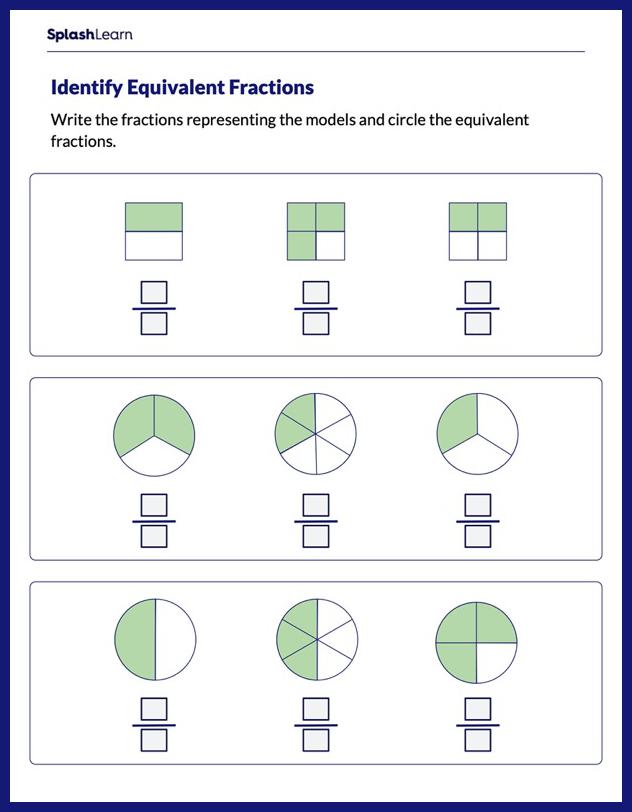What Are Circle Theorems in Geometry?
The circle theorems in geometry are statements that prove significant results about circles. These theorems provide important information or facts about various parts of a circle.
We can use circle theorems and previous knowledge of properties of a circle to calculate missing angles. The circle angle theorems give us the rules for finding the measurements of angles in a circle.
A circle is a locus of points that are equidistant from a fixed point called center. Different theorems are based on the various parts of a circle, such as radius, central angles, tangents, sectors, the chords, etc. These theorems help us to solve many problems in geometry easily.
Before we discuss the theorems, let’s revise the parts of the circle using a diagram.
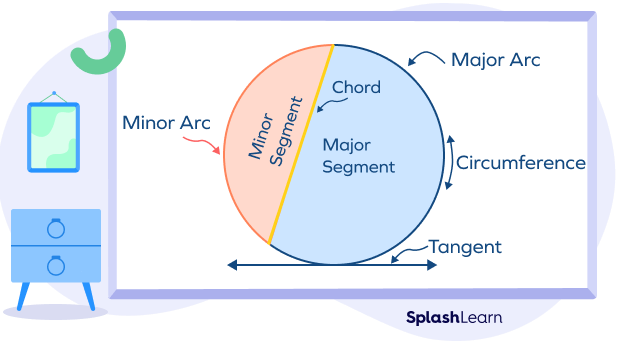
Recommended Games
Important Terms Related to Circle Theorems
Here are a few important terms that are commonly used in the statements of circle theorems.
Subtended angle: The angle made by something (arc, chord, etc) from a given viewpoint. An angle within a circle created by two chords meeting at a point on the circumference. In a circle, there are various angles that can be formed joining the endpoints of arcs and those angles are termed subtended angles.
Inscribed Angle: An angle made from points lying on the circle’s circumference. It can also be defined as the angle subtended at a point on the circle by two given points on the circle. Thus, it is formed by two chords that have a common endpoint on the circle.
Central Angle: An angle whose vertex is the center O of a circle and whose legs (sides) are radii intersecting the circle in two distinct points.
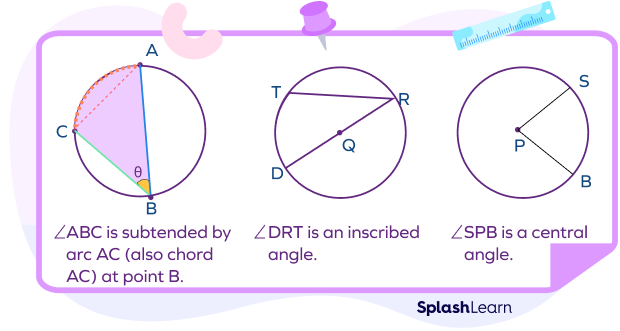
Recommended Worksheets
Circle Theorems
We will discuss the following circle theorems in detail.
- Alternate segment theorem
- The angle at the center theorem
- Angles in the same segment theorem
- Angle in a semicircle theorem
- Chord of a circle theorem
- Cyclic quadrilateral theorem
- Tangent of a circle theorem-1
- Tangent of a circle theorem-2
Circle Theorem 1: Alternate Segment Theorem
Alternate Segment Theorem: For any circle, the angle formed between the tangent and the chord through the point of contact of the tangent is equal to the angle formed by the same chord in the alternate segment.
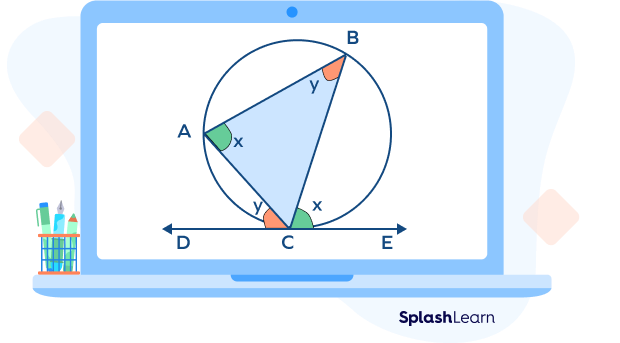
Here, according to the alternate segment theorem,
- ∠x = ∠BCE = ∠BAC
Here, ∠BCE is the angle made by the tangent and the chord BC at the point of contact.
∠BAC is the angle made by the same chord BC in the alternate segment BAC.
- Similarly, ∠y = ∠ABC = ∠ACD
Circle Theorem 2: Central Angle Theorem (The Angle at the Center Theorem)
Central Angle Theorem: The central angle subtended by two points on a circle is always twice the inscribed angle subtended by those points.
Here, the angle BAC is known as the inscribed angle, an angle made from points lying on the circle’s circumference.
The angle BOC is the central angle, an angle whose vertex is the center O of a circle and whose legs (sides) are radii intersecting the circle in two distinct points B and C.
Thus, the theorem states that an inscribed angle ∠BAC = x° is half of the measure of the central angle ∠BOC = 2x°.
∠BOC = 2 ∠BAC.

Circle Theorem 3: Angles in the Same Segment Theorem
Angles in the same segment theorem: Angles formed in the same segment (either major segment or minor segment) of a circle are equal.
Here, according to the angles in the same segment theorem: ∠BAD = ∠BCD

Circle Theorem 4: Angle in a Semicircle Theorem
Angle in a semicircle theorem: An angle in a semicircle is always a right angle (measures 90 degrees).
In other words, an angle subtended by a circle’s diameter is always a right angle.

Here, according to the angle in a semicircle theorem: ∠A = ∠B = ∠C = 900

Circle Theorem 5: Chord of a Circle Theorem
Chord of a circle theorem: The perpendicular drawn from the center of the circle to a chord bisects the chord.
Here, according to the chord of a circle theorem, we have
∠OPA = ∠OPB = 900
AP = PB
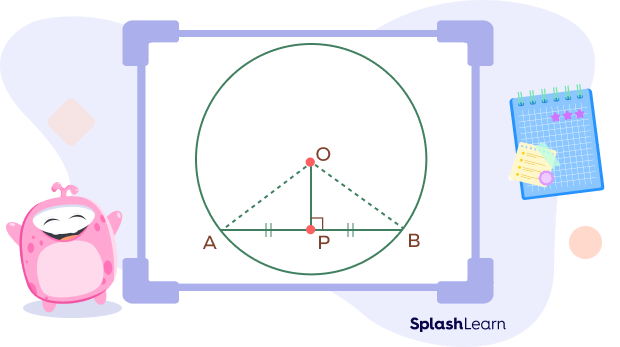
Circle Theorem 6: Angles Subtended by Equal Chords Theorem
Angles subtended by equal chords theorem: Two equal chords of a circle subtend equal angles at the center of the circle.
The converse is also true. If two angles subtended at the center by two chords are equal, then the chords are of equal length.
In the given diagram, the chords XY and ST are equal. Thus, the angles subtended by them are also equal.
∠AOB = ∠POQ

Circle Theorem 7: Cyclic Quadrilateral Theorem
Cyclic quadrilateral theorem: The sum of opposite angles in a cyclic quadrilateral is equal to 1800.
A cyclic quadrilateral is a quadrilateral where all four vertices lie on a circle.

Here, ABCD is a cyclic quadrilateral. According to the cyclic quadrilateral theorem:
∠A + ∠C = 1800 and ∠B + ∠D = 1800
Circle Theorem 8: Tangent of a Circle Theorem-1
Tangent of a circle theorem-1: The tangent makes a right angle with the radius of a circle at the point of tangency.
In the given diagram, the radius OP is perpendicular to the tangent AB.
OP ⊥ AB.
∠OPA = ∠OPB = 900.
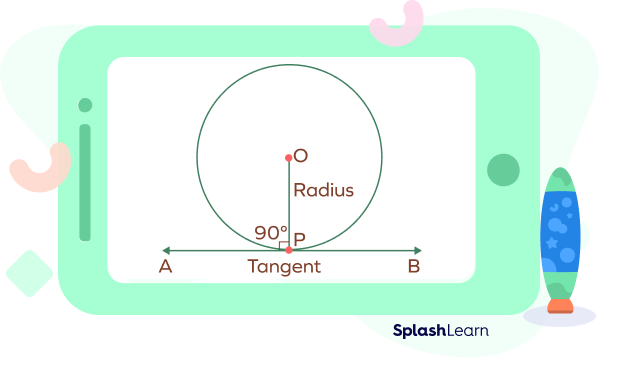
Circle Theorem 9: Two Tangents Theorem
If two tangent lines PA and PB are drawn from an external point, then
- Two tangents have the same length. (PA = PB)
- The two tangents subtend equal angles at the center of the circle. (∠POA = ∠POB)
- The line that connects the exterior point to the center will divide the angle between the tangents into two equal angles. (∠OPA = ∠OPB)

Circle Theorems Formulas
| Theorems | Shapes | Formula |
|---|---|---|
| Alternate Segment Theorem | 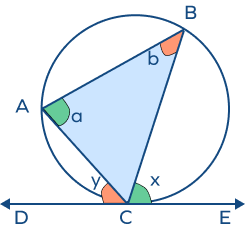 | ∠x = ∠y and ∠a = ∠b |
| The central angle subtended by two points on a circle is always twice the inscribed angle subtended by those points. | 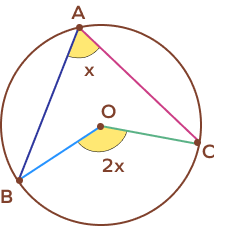 | ∠BOC = 2∠BAC |
| Angles in the same segment are congruent. | 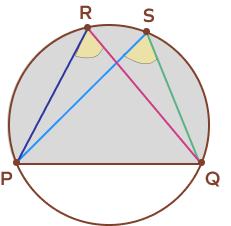 | ∠PRQ = ∠PSQ |
| Angles in a semicircle are right angles. | 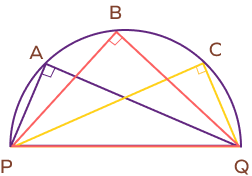 | ∠A = ∠B = ∠C = 900 |
| Chord of a circle theorem | 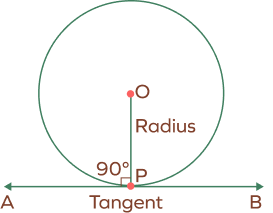 | AP = PB ∠OPA = ∠OPB = 900 |
| Angles subtended by equal chords | 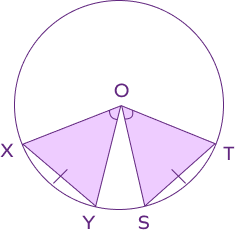 | ∠XOY = ∠SOT |
| Cyclic quadrilateral theorem | 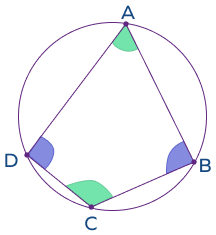 | ∠A + ∠C = 1800 and ∠B + ∠D = 1800 |
| Tangent of a circle theorem-1 | 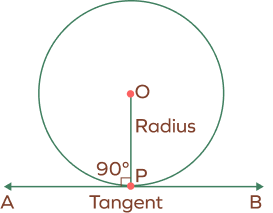 | ∠OPA = ∠OPB = 900 |
| Tangent of a circle theorem-2 | 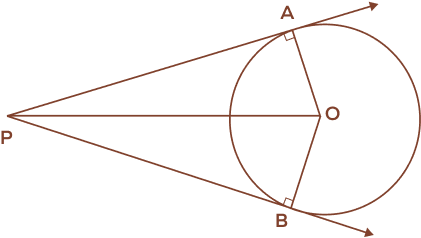 | PA = PB∠POA = ∠POB∠OPA = ∠OPB |
Facts about Circle Theorems
- The first theorems based on the circles are attributed to Thales around 650 BC.
- In the fields of engineering and design, the circle theorems have important applications.
Conclusion
In this article, we delved into the essential circle theorems that provide valuable insights into angles, arcs, and their relationships within a circle. Understanding these theorems is crucial for various geometric applications. Now, let’s reinforce our knowledge by tackling examples and practicing MCQs for better comprehension.
Solved Examples on Circle Theorems
- In the circle given below, triangle ABC is inscribed in the circle and the tangent DE meets the circle at the point B. Find the measure of angle “x” and “y.”
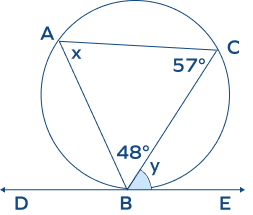
Solution:
We know that the sum of interior angles of a triangle is equal to 180.
∠BAC + ∠ACB + ∠ABC = 1800
x + 570 + 480 = 1800
x = 1800 – 1050
x = 750
Now, according to the alternate segment theorem, the angle formed between the tangent and the chord through the point of contact of the tangent is equal to the angle formed by the same chord in the alternate segment.
x = y = 750
Hence, the measure of ∠x and ∠y is 750.
- In the figure given below, find the value of x using the circle theorems.
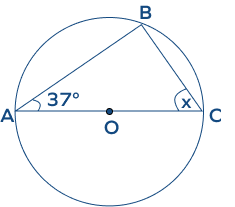
Solution:
In the given figure, ∠ABC is an angle in a semicircle.
Angle in a semicircle is always a right angle.
Thus, m∠ABC = 900
We know that the sum of interior angles of a triangle is equal to 1800.
m∠BAC + m∠ACB + m∠ABC = 1800
x + 370 + 900 = 1800
x + 1270 = 1800
x = 1800 − 1270 = 530
Hence, the value of x is 530.
- In the figure given below, find the value of x using the circle theorems.
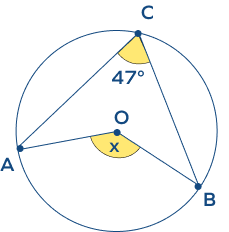
Solution:
According to “the angle at the center theorem,” the central angle subtended by two points on a circle is always twice the inscribed angle subtended by those points.
∠AOB = 2∠ACB.
x = 2 × 470 = 940
The value of x is 940.
- In the given figure, the point O is a center of a circle, the radius of a circle is 17 inches and OP = 8 inches. Find the length of the chord AB.
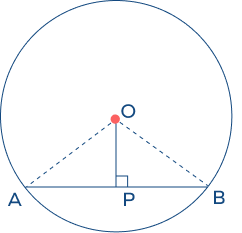
Solution:
In the given figure,
OA = OB = 17 inches
OP = 8 inches
OP⊥ AB
Using pythagoras theorem in triangle OPB, we get
OP2 + PB2 = OB2
82 + PB2 = 172
PB2 = 172 − 82 = 225
Therefore, PB = $\sqrt{225}$ = 15 inches
According to the chord of a circle theorem, the perpendicular drawn from the center of the circle bisects the chord.
Thus, AP = PB
∴ AB = AP + PB = 15 inches + 15 inches = 30 inches.
Hence, the length of the chord AB is 30 inches.
- Find the value of “x” and “y” using the cyclic quadrilateral theorem.
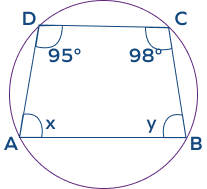
Solution:
In the given figure, ABCD is cyclic quadrilateral.
We know that the sum of opposite angles in a cyclic quadrilateral is equal to 1800.
So, x + 980 = 1800
x = 1800 − 980 = 820
Similarly,
y + 950 = 1800
x = 1800 − 950 = 850
The values of x and y are 82 and 85 respectively.
- Find the value of “x” in the figure given below.
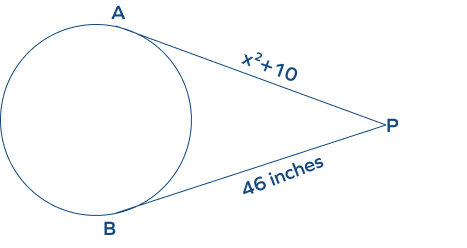
Solution:
Two tangent lines PA and PB are drawn from an external point “P” as shown in the figure, then two tangents have the same length.
Thus, PA = PB.
x2 + 10 = 46
x2 = 46 − 10
x2 = 36
x = 6
Hence, the value of “x” is 6.
Practice Problems on Circle Theorems
Circle Theorems: Definition, Formulas, Steps, Examples, FAQs
The angle subtended by a diameter at any point of the circumference is equal to _______.
The angle subtended by a diameter at any point of the circumference is equal to $90^{\circ}$.
If the inscribed angle is $50^{\circ}$, then the central angle is ________.
We know that the inscribed angle is half of the measure of the central angle.
Central angle $= 2 \times 50^{\circ} = 100^{\circ}$
The opposite angles in a cyclic quadrilateral are ______.
The opposite angles in a cyclic quadrilateral are supplementary. They add up to $180^{\circ}$.
Angles formed in the same segment of a circle are ______.
Angles formed in the same segment of a circle are always equal.
Frequently Asked Questions on Circle Theorems
Why are circle theorems important?
Geometry problems can be solved with the help of circle theorems. There are a number of useful patterns and theorems that can be deduced from drawing angles and lines inside a circle, which we can use in both practical and theoretical situations.
How to find angles using circle theorems?
To find angles using the circle theorems based on a given condition and shape, we can apply circle theorems based on angles. Some important circle theorems based on angles are as follows:
- The measure of angles subtended by an arc at the center of a circle is equal to twice the angles at any point on the circumference of the circle from the same arc.
- Angles formed in the same segment of a circle are equal.
- The angle in a semicircle is always 90 degrees.
The sum of opposite angles in a cyclic quadrilateral is equal to 1800.
Why is it called a circle?
The word circle is derived from the Greek word kirkos, meaning hoop or ring.
List the circle theorems.
Following are the list of circle theorems:
- Alternate segment theorem
- The angle at the center theorem
- Angles in the same segment theorem
- Angle in a semicircle theorem
- Chord of a circle theorem
- Cyclic quadrilateral theorem
- Tangent of a circle theorems
What is a cyclic quadrilateral?
A quadrilateral with all four vertices lying on a circle is known as a cyclic quadrilateral. Sometimes, It is also known as the inscribed quadrilateral. The sum of opposite angles in a cyclic quadrilateral is equal to 1800.
What is the sum of all angles of a cyclic quadrilateral?
As we know that the sum of all angles of a quadrilateral is equal to 3600. Hence, the sum of all angles of a cyclic quadrilateral is also equal to 3600.



















